What is the purpose of this lens
Mar 7, 2017 14:30:00 #
OddJobber wrote:
Now you have me confused. You say this is a comparison of tilt-shift and normal lens but this is an example of perspective correction with post processing. Then what is gained by spending $1K to $3K for a tilt-shift lens? My only guess is that the post-production perspective correction would result in lower resolution at the top of the image compared to the bottom?
Inquiring minds want to know!
Inquiring minds want to know!

Mar 7, 2017 14:36:46 #
The few images that I make that would be improved by the use of a T&S lens have never justified the expense. But if I lived in a city and did a lot of city scenes I would own one. The PP processing does get onerous if you need to do very much of it.
Mar 7, 2017 14:50:05 #
The perspective is only one of the advantages. It's ability to change dept of field without using f/stops or distance to subject is amazing. It's ability to make very accurate panos to be stitched and not worrying about parallax is great.
Mar 7, 2017 16:02:15 #
Is the bellows you have the Nikon PB4? If not, what is it? Can you use it with all focal lengths or just for macro shots?
cthahn wrote:
Not easy to describe and understand. Do a search on the internet and you will find a description and drawings showing how a shift and tilt lens functions. I have a shift and tilt bellows which can be used with any lens.
Mar 7, 2017 16:33:41 #
The first editions of the series were 5 books. "The Camera", "The Negative", "The Print", "Natural Light Photography", and "Artificial Light Photography". They have been combined into three now, "The Camera", "The Negative", and "The Print".
--Bob
--Bob
mikeyboccato wrote:
I recommend finding an old copy of the book "The Camera" by Ansel Adams. It is one of a trio that he wrote (add the Print and The Negative) which are fun reading if you love photography, and are very educational even though they were written long before the digital age. I think the TS lenses were designed years before we had post processing capabilities to achieve similar effects.
Mar 7, 2017 16:46:14 #
JimmydaCreek
Loc: Montgomery, AL
Does your bellows allow focus to infinity, or just macro? If it allows infinity focus, please describe fully. I'd like to have one
Mar 7, 2017 17:42:20 #
TonyL wrote:
Other subscribers have explained what a T & S lens is all about. My understanding is that they are quite difficult/complicated to use as well as being very expensive. Hence their main use by professionals who specialise in or concentrate on photographing structures. I believe the same effects can be achieved in post processing.
That is a bit of a myth. Yes, they are costly - the Nikon flavors are all around $2000 except for the $3400 19mm PC-E. I own the other three - 24, 45 and 85. My 45 and 85 are my "go to" lenses for street, landscape and general nature photography. Not at all suitable for wildlife (manual focus only), but quite sharp and excellent for most tasks where you can spend a few minutes to set up a shot. They all go to 1:2 magnification, so using them for closeups is really a joy. Having the tilt helps with landscapes to extend depth of field without having to resort to tiny apertures. With my 85 mm lens set to F2.8 I can extend my DoF from about 4 ft in front of me to infinity, and it is much sharper than had I used F32. The shift is great when composing a stitched pano, where all you have to do is shift the lens from one extreme to the other to get a complete picture without having to rotate the camera. The really serious photographers that use these lenses for panos actually use a tripod collar that grips the lens so that when you shift, you are not moving the lens, but actually moving the camera from left to right, up or down.
T/S lenses are far more useful than just for architectural use, and they have a flat field and relative freedom from pincushion, barrel or complex (mustache) distortion. And they are not that more expensive than the non-T/S counterparts. A Nikkor 24mm F1.4 is $2000, and the 24 mm PC-E is $2200.
They are quite easy to use - you'll figure out the shift in seconds, and the tilt will take a little more work, but it's not that hard.
Mar 7, 2017 18:29:45 #
TonyL wrote:
Other subscribers have explained what a T & S lens is all about. My understanding is that they are quite difficult/complicated to use as well as being very expensive. Hence their main use by professionals who specialise in or concentrate on photographing structures. I believe the same effects can be achieved in post processing.
Yes -- and the work that I've seen done by someone who is dedicated to using a T/S lens well was of very high quality and was considered worth the expense and effort. There's nothing wrong with that, even if the rest of us prefer to spend our time and resources differently.
I may be remembering this incorrectly, but isn't it possible to do a better job of stitching a panel of images together more precisely if images are from properly-adjusted T/S sections? (yes, this would be very time intensive and technically persnickety)
Another old "film-days" way to somewhat adjust an image w/o a T/S lens on camera -- during printing while tilting the lens board and/or easel.
Mar 7, 2017 18:34:10 #
dar_clicks wrote:
Yes -- and the work that I've seen done by someone... (show quote)
Yes, on the tilt shift stitch question.
Mar 7, 2017 20:53:36 #
Jon, I don't have one, but I'm disappointed to hear that it won't do any of the things you mentioned to enhance my mundane life. If you know of a lens that will, please let me know ASAP. Thanks
Mar 8, 2017 13:53:18 #
DI Seller wrote:
Can someone tell me the purpose of a tilt & shift lens such as the Nikkor 45 or 85mm PC-E micro lenses. Let me also say that I think http://www.uglyhedgehog.com/compose-topic-screen?sectnum=1#all of you out there are outstanding. I have gained so much by reading your posts. 

All images are uncropped, using a D800.
First three are self explanatory - camera level, no shift, camera tilted up, camera level shift as necessary to get entire house in the frame.
The next two images show the effect of tilt. When you tilt the lens downward, you change the plane of focus to a cone of focus, and it angles downward. The end result is an extension of the depth of field, sort of. Changing the aperture serves to widen the angle of the cone.
The first image, taken at F11, shows decent focus from around 4 ft in the foreground to about 200 ft and beyond in the distance - you can read the license plate numbers on the truck.
The second shows what I actually focused on, and a very narrow cone of focus - you can see the center of the large colonial but not the roof or the fence, are in focus. In the foreground the closest leaves in the Yew are sharp, then the Boxwood is out of the cone of focus, as is the Rhododendron at the left edge, but the stop sign is in focus along with the house directly behind it in the line of sight, and the one next to it on the right. When you use a small aperture this mostly goes away, but wide open you will get depth, but it will be a narrow "field of focus." You can see, the truck is outside the cone of focus in the second image, but in the house behind the truck, the top of the first floor and the bottom of the second floor is in the cone -
This may add to the confusion, but hopefully it makes some sense and some may find it provides a little clarity.
24mm PC-E camera level, no shift
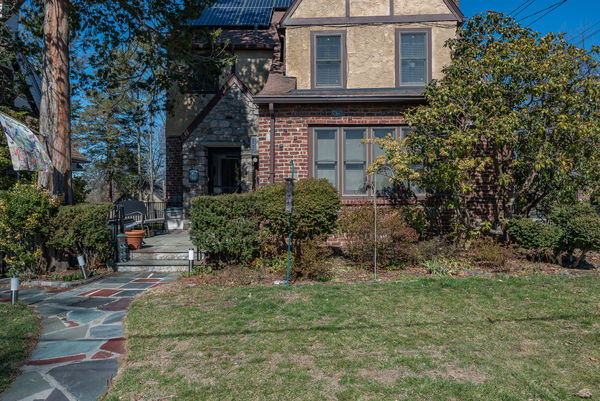
(Download)
24mm PC-E camera pivoted upward to "get it all in," no shift
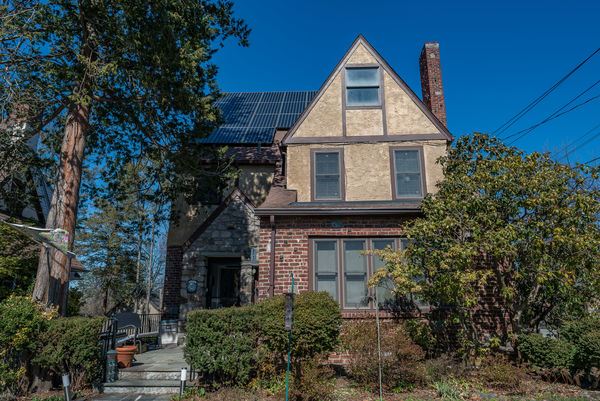
(Download)
24mm PC-E camera level, lens shifted up
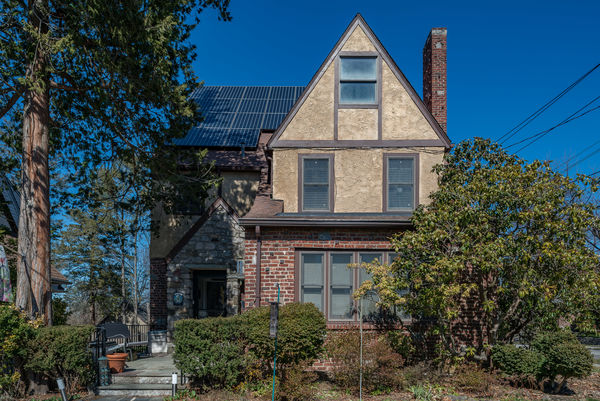
(Download)
45mm PC-E, lens tilted down about 4 deg, F11
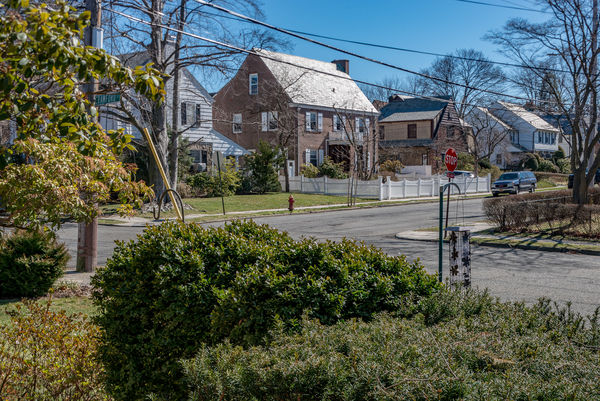
(Download)
45mm PC-E, lens tilted down about 4 deg, F2.8
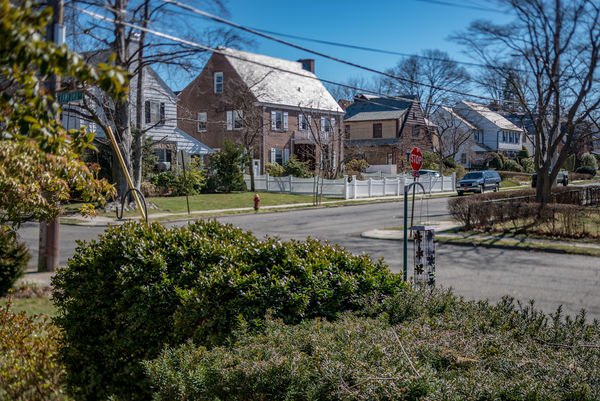
(Download)
Mar 11, 2017 14:32:45 #
Gene51 wrote:
All images are uncropped, using a D800. br br Fir... (show quote)
Nice examples -- thanks for showing them.
Mar 11, 2017 15:48:01 #
Gene, I probably already know the answer to this question, but what do you think of the bellows system like the Nikon PB4 for tilt and shift use in architecture and landscapes? I'm guessing it wont focus to infinity with most or all of the Nikkor film lenses, and won't auto focus or meter, but with buildings and some landscapes that probably doesn't matter all that much.
Bob
Bob
Gene51 wrote:
All images are uncropped, using a D800. br br Fir... (show quote)
Mar 11, 2017 19:38:41 #
Bobspez wrote:
Gene, I probably already know the answer to this question, but what do you think of the bellows system like the Nikon PB4 for tilt and shift use in architecture and landscapes? I'm guessing it wont focus to infinity with most or all of the Nikkor film lenses, and won't auto focus or meter, but with buildings and some landscapes that probably doesn't matter all that much.
Bob
Bob
The bigger question is which lenses are you going to use it with? Most lenses do not have a back focus distance to allow for more than macro or closeup work, and you can forget about buildings, where infinity focus is not possible, and even less so if you incorporate shift/tilt.
Nikon's PC-E lenses have a much larger image circle to eliminate vignetting. This article has an illustration of just how large the image circle is compared to a standard FX lens.
https://luminous-landscape.com/nikon-24-mm-f3-5-pc-e-nikkor-ed/
Infinity focus is possible with enlarging lenses and a Nikon F to M39 adapter (Leica thread). I've heard that the 50mm F2.8 EL Nikkor, 105, 135 will all focus to infinity, but I can't tell you how large the image circle might be and whether or not you can use shift and tilt.
I used to have a Leica M4 and the Leica bellows for it - but if I remember correctly you could unscrew the back of the lens and attach it to the bellows and the Visoflex housing - to make a great macro-focusing rangefinder/SLR camera. It was more a conversation piece than something I used much, but it was cool.
Mar 11, 2017 19:39:06 #
dar_clicks wrote:
Nice examples -- thanks for showing them.
Thanks!
If you want to reply, then register here. Registration is free and your account is created instantly, so you can post right away.







